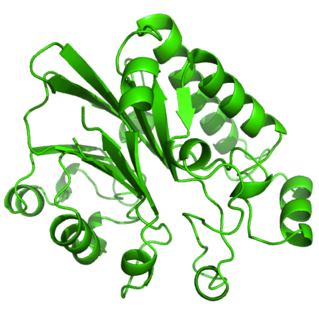
Nicotinamide adenine dinucleotide phosphate, abbreviated NADP+ or, in older notation, TPN (triphosphopyridine nucleotide), is a cofactor used in anabolic reactions, such as the Calvin cycle and lipid and nucleic acid syntheses, which require NADPH as a reducing agent ('hydrogen source'). It is used by all forms of cellular life.

Exonucleases are enzymes that work by cleaving nucleotides one at a time from the end (exo) of a polynucleotide chain. A hydrolyzing reaction that breaks phosphodiester bonds at either the 3′ or the 5′ end occurs. Its close relative is the endonuclease, which cleaves phosphodiester bonds in the middle (endo) of a polynucleotide chain. Eukaryotes and prokaryotes have three types of exonucleases involved in the normal turnover of mRNA: 5′ to 3′ exonuclease (Xrn1), which is a dependent decapping protein; 3′ to 5′ exonuclease, an independent protein; and poly(A)-specific 3′ to 5′ exonuclease.

Apurinic/apyrimidinic (AP) endonuclease is an enzyme that is involved in the DNA base excision repair pathway (BER). Its main role in the repair of damaged or mismatched nucleotides in DNA is to create a nick in the phosphodiester backbone of the AP site created when DNA glycosylase removes the damaged base.

Exonuclease III (ExoIII) is an enzyme that belongs to the exonuclease family. ExoIII catalyzes the stepwise removal of mononucleotides from 3´-hydroxyl termini of double-stranded DNA. A limited number of nucleotides are removed during each binding event, resulting in coordinated progressive deletions within the population of DNA molecules.
An esterase is a hydrolase enzyme that splits esters into an acid and an alcohol in a chemical reaction with water called hydrolysis.

Phosphatidylinositol (3,4)-bisphosphate is a minor phospholipid component of cell membranes, yet an important second messenger. The generation of PtdIns(3,4)P2 at the plasma membrane activates a number of important cell signaling pathways.
Deoxyribonuclease IV (phage-T4-induced) is a kind of Endonuclease that catalyzes the degradation nucleotides in DsDNA by attacking the 5'-terminal end.

DNA-(apurinic or apyrimidinic site) lyase is an enzyme that in humans is encoded by the APEX1 gene.

Flap endonuclease 1 is an enzyme that in humans is encoded by the FEN1 gene.

Src homology 2 (SH2) domain containing inositol polyphosphate 5-phosphatase 1(SHIP1) is an enzyme with phosphatase activity. SHIP1 is structured by multiple domain and is encoded by the INPP5D gene in humans. SHIP1 is expressed predominantly by hematopoietic cells but also, for example, by osteoblasts and endothelial cells. This phosphatase is important for the regulation of cellular activation. Not only catalytic but also adaptor activities of this protein are involved in this process. Its movement from the cytosol to the cytoplasmic membrane, where predominantly performs its function, is mediated by tyrosine phosphorylation of the intracellular chains of cell surface receptors that SHIP1 binds. Insufficient regulation of SHIP1 leads to different pathologies.

Deoxyribonuclease-1-like 1 is an enzyme that in humans is encoded by the DNASE1L1 gene.

Type I inositol-3,4-bisphosphate 4-phosphatase is an enzyme that in humans is encoded by the INPP4A gene.

Type II inositol-1,4,5-trisphosphate 5-phosphatase is an enzyme that in humans is encoded by the INPP5B gene.

Type I inositol-1,4,5-trisphosphate 5-phosphatase is an enzyme that in humans is encoded by the INPP5A gene.

Inositol polyphosphate 1-phosphatase is an enzyme that, in humans, is encoded by the INPP1 gene. INPP1 encodes the enzyme inositol polyphosphate-1-phosphatase, one of the enzymes involved in phosphatidylinositol signaling pathways. This enzyme removes the phosphate group at position 1 of the inositol ring from the polyphosphates inositol 1,4-bisphosphate and inositol 1,3,4-trisphophosphate.

CCR4-NOT transcription complex subunit 6 is a protein that in humans is encoded by the CNOT6 gene.
72 kDa inositol polyphosphate 5-phosphatase, also known as phosphatidylinositol-4,5-bisphosphate 5-phosphatase or Pharbin, is an enzyme that in humans is encoded by the INPP5E gene.

Inositol polyphosphate-4-phosphatase, type II, 105kDa is a protein that in humans is encoded by the INPP4B gene.

Inositol polyphosphate-5-phosphatase F is a protein that in humans is encoded by the INPP5F gene.

Nocturnin is a human hydrolase enzyme that is involved in metabolism and its expression is controlled by the rhythmic circadian clock. It is encoded by the NOCT gene located on chromosome 4. Nocturnin contains a c-terminal structural domain of the Endonuclease/Exonuclease/phosphatase family. A study in January 2019, demonstrated that NADP+ and NADPH are the direct targets of Nocturnin.














